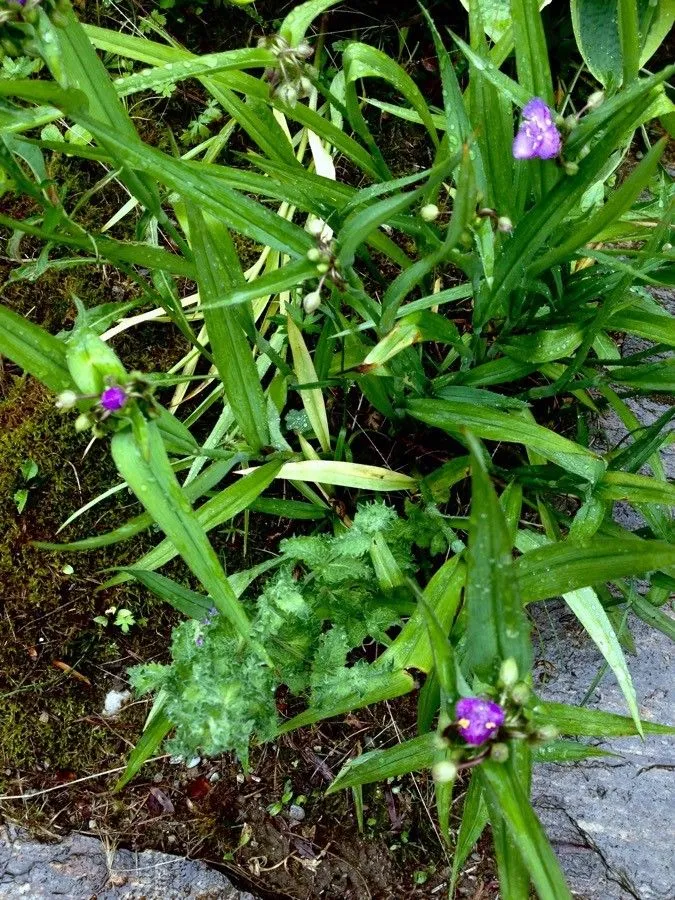
Author: L.
Bibliography: Sp. Pl.: 288 (1753)
Year: 1753
Status: accepted
Rank: species
Genus: Tradescantia
Vegetable: False
Observations: Ontario to EC. & E. U.S.A., Cuba
White spiderwort, scientifically known as Tradescantia virginiana, is a notable member of the Commelinaceae family. This distinctive plant garners attention with its graceful, arching stems and elegant blooms that captivate botanists and gardening enthusiasts alike. Native to the diverse regions stretching from Ontario through the eastern-central and eastern United States, and even Cuba, the White spiderwort has successfully made its presence known across various landscapes.
Originally described by the renowned botanist Carl Linnaeus in 1753, as recorded in his seminal work “Species Plantarum” (Sp. Pl.: 288), Tradescantia virginiana has been subject to admiration and study for centuries. The plant typically thrives in moist, well-drained soils and can often be found in meadows, woodland borders, and alongside stream banks.
One of the most striking features of the White spiderwort is its unique tri-petaled flowers, which can range in shades from white to light blue or violet. These blooms, preferring the gentle morning sunlight, often last only a single day, but are quickly replaced with new ones, ensuring a continuous display of beauty throughout its blooming season.
In addition to its aesthetic appeal, Tradescantia virginiana holds interest for its ecological roles. It provides nectar and pollen for various pollinators, including bees and butterflies, thus contributing to the health of local ecosystems. Moreover, its adaptability to different environmental conditions makes it a resilient plant suitable for various garden settings, be it ornamental gardens or naturalized areas.
The White spiderwort’s foliage also contributes to its charm, with long, narrow leaves that gracefully complement the upright flower stems. These lush leaves maintain their vibrancy throughout the growing season, adding a verdant backdrop to the plant’s delicate flowers.
In conclusion, Tradescantia virginiana, or White spiderwort, is not only an eye-catching addition to any landscape but also a testament to nature’s resilience and beauty. Its historical significance and ecological contributions make it a plant worth appreciating and understanding, both in the wild and in curated garden spaces.
Dan: blomsterjøde
Ita: erba miseria, fiore d’un giorno
Deu: garten-dreimasterblume, virginische dreimasterblume
Eng: spiderwort, virginia spiderwort, white spiderwort, widow’s-tears
Hun: virginiai tradeszkancia
Fra: éphémère de virginie, tradescantie de virginie
Swe: ängstremastarblomma, tremastarblomma
Nld: eendagsbloem
Cym: llysiau’r pryf copyn
En: White spiderwort, Virginia spiderwort, Widow’s-tears, Spiderwort
Cs: Podeňka virginská
Da: Blomsterjøde
Nl: Eendagsbloem
Et: Virgiinia tradeskantsia
Fr: Éphémère de Virginie, Tradescantie de Virginie
De: Garten-Dreimasterblume, Virginische Dreimasterblume
Hu: Virginiai tradeszkancia
It: Erba Miseria, Fiore d’un giorno, Tradescanzia
Fa: ترادسکانتیا ویرجینیانا
Ru: Традесканция виргинская
Sv: Ängstremastarblomma, Tremastarblomma
Cy: Llysiau‘r pryf copyn, Llysiau’r Pryf Copyn
Taken Jun 21, 2022 by Sabina Hartmann (cc-by-sa)
Taken Jun 1, 2014 by Alain Bigou (cc-by-sa)
Taken Aug 4, 2021 by Dieter Wagner (cc-by-sa)
Taken Jun 8, 2020 by Sabina Hartmann (cc-by-sa)
Taken Jun 26, 2019 by Dieter Wagner (cc-by-sa)
Taken Mar 17, 2018 by iana (cc-by-sa)
Taken Jun 10, 2018 by Nicolas Gallant (cc-by-sa)
Taken Jun 26, 2019 by Dieter Wagner (cc-by-sa)
Taken Jun 26, 2019 by Dieter Wagner (cc-by-sa)
Taken Jun 26, 2019 by Dieter Wagner (cc-by-sa)
Taken Sep 8, 2019 by Bart Vroklage (cc-by-sa)
Taken May 20, 2022 by William Coville (cc-by-sa)
Taken Apr 25, 2018 by Annie Elle (cc-by-sa)
Taken Jun 26, 2019 by Dieter Wagner (cc-by-sa)
Taken May 31, 2020 by Gary Allmyer (cc-by-sa)
Taken Jan 12, 2021 by Gianni Del Bufalo (cc-by-sa)
Taken Jan 12, 2021 by Gianni Del Bufalo (cc-by-sa)
Taken Jun 27, 2022 by Tristan Jaton-Maria (cc-by-sa)
Taken May 29, 2022 by Fabrice Rubio (cc-by-sa)
Taken Jul 29, 2021 by Dieter Wagner (cc-by-sa)
Taken Jun 5, 2022 by William Coville (cc-by-sa)
Taken Aug 13, 2022 by Krzysztof Golucki (cc-by-sa)
Taken Apr 11, 2022 by Stephen Herren (cc-by-sa)
Taken Jun 5, 2021 by barbara caroli (cc-by-sa)
Taken Aug 2, 2022 by Jim Knopf (cc-by-sa)
Taken Jun 4, 2022 by tufty_jam_bean (cc-by-sa)
Taken Jul 2, 2019 by carly carly Saunt (cc-by-sa)
Taken Jul 29, 2020 by Martijn Jongen (cc-by-sa)
Taken Aug 8, 2017 by MICHEL DUSSERE (cc-by-sa)
Taken Apr 17, 2004 by EOL − Steven J. Baskauf (cc-by-nc-sa)
© copyright of the Board of Trustees of the Royal Botanic Gardens, Kew.
© copyright of the Board of Trustees of the Royal Botanic Gardens, Kew.
© copyright of the Board of Trustees of the Royal Botanic Gardens, Kew.
Growth form>: Single Stem
Growth habit>: Forb/herb
Growth rate>: Rapid
Ph maximum: 8.0
Ph minimum: 4.0
Family: Myrtaceae Author: (F.Muell.) K.D.Hill & L.A.S.Johnson Bibliography: Telopea 6: 402 (1995) Year: 1995 Status:…
Family: Rubiaceae Author: Pierre ex A.Froehner Bibliography: Notizbl. Bot. Gart. Berlin-Dahlem 1: 237 (1897) Year:…
Family: Sapindaceae Author: Koidz. Bibliography: J. Coll. Sci. Imp. Univ. Tokyo 32(1): 38 (1911) Year:…
Family: Asteraceae Author: A.Gray Bibliography: Pacif. Railr. Rep.: 107 (1857) Year: 1857 Status: accepted Rank:…
Family: Fabaceae Author: Medik. Bibliography: Vorles. Churpfälz. Phys.-Ökon. Ges. 2: 398 (1787) Year: 1787 Status:…
Family: Aspleniaceae Author: (Cav.) Alston Bibliography: Bull. Misc. Inform. Kew 1932: 309 (1932) Year: 1932…